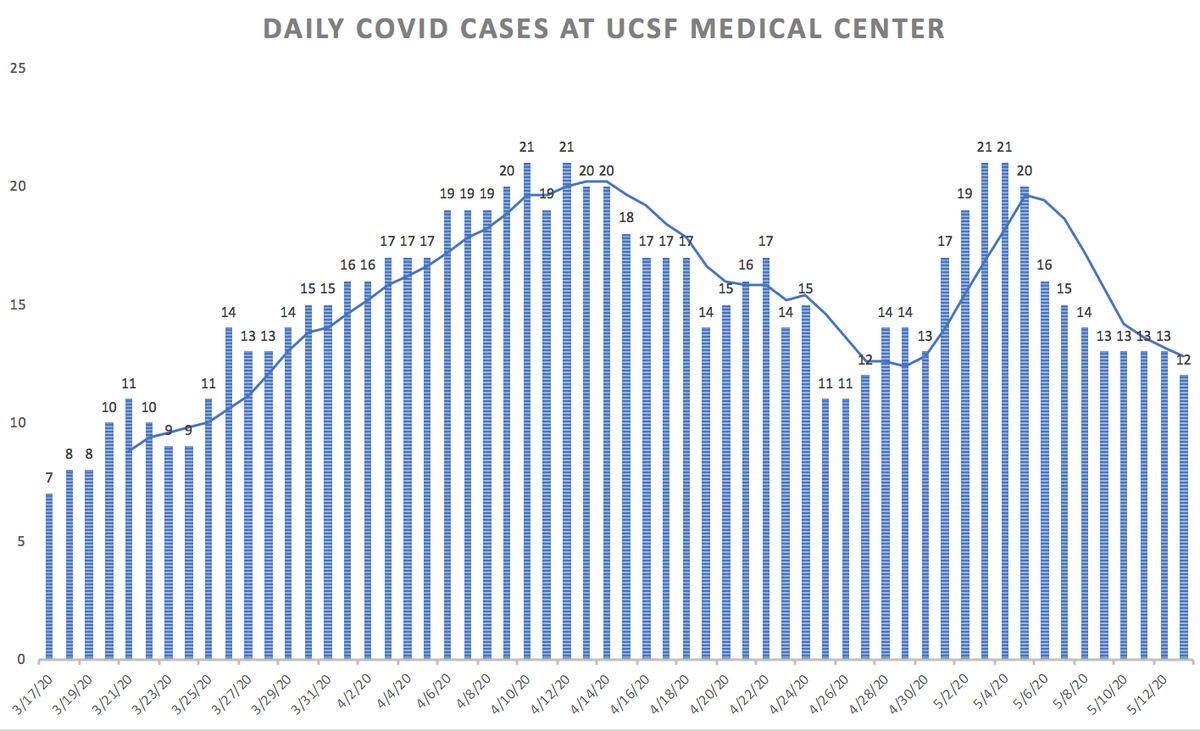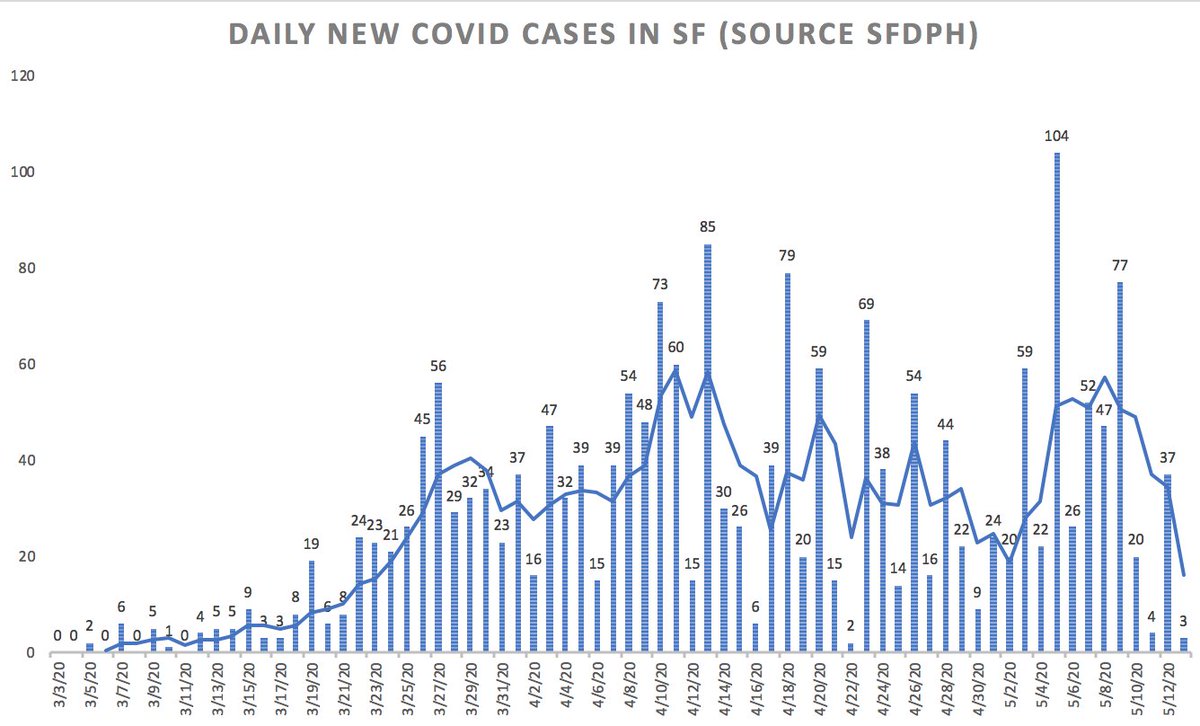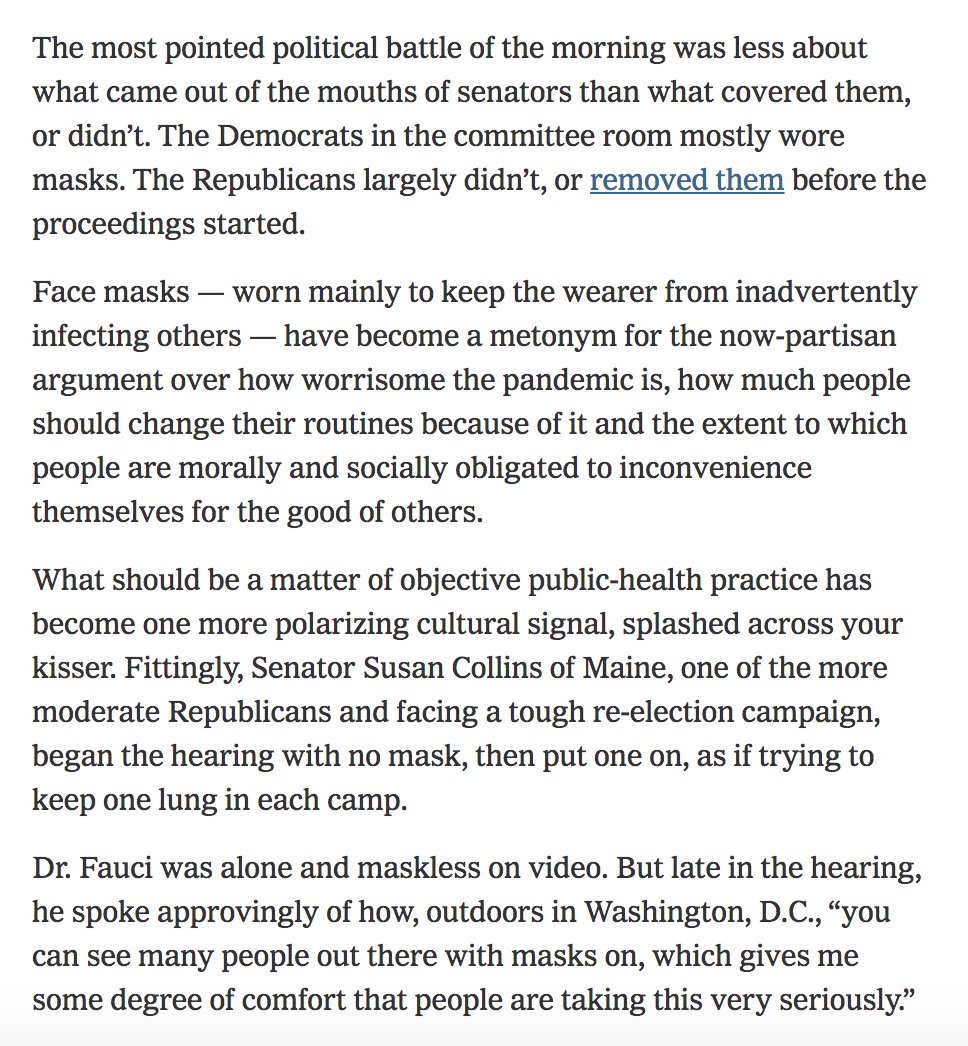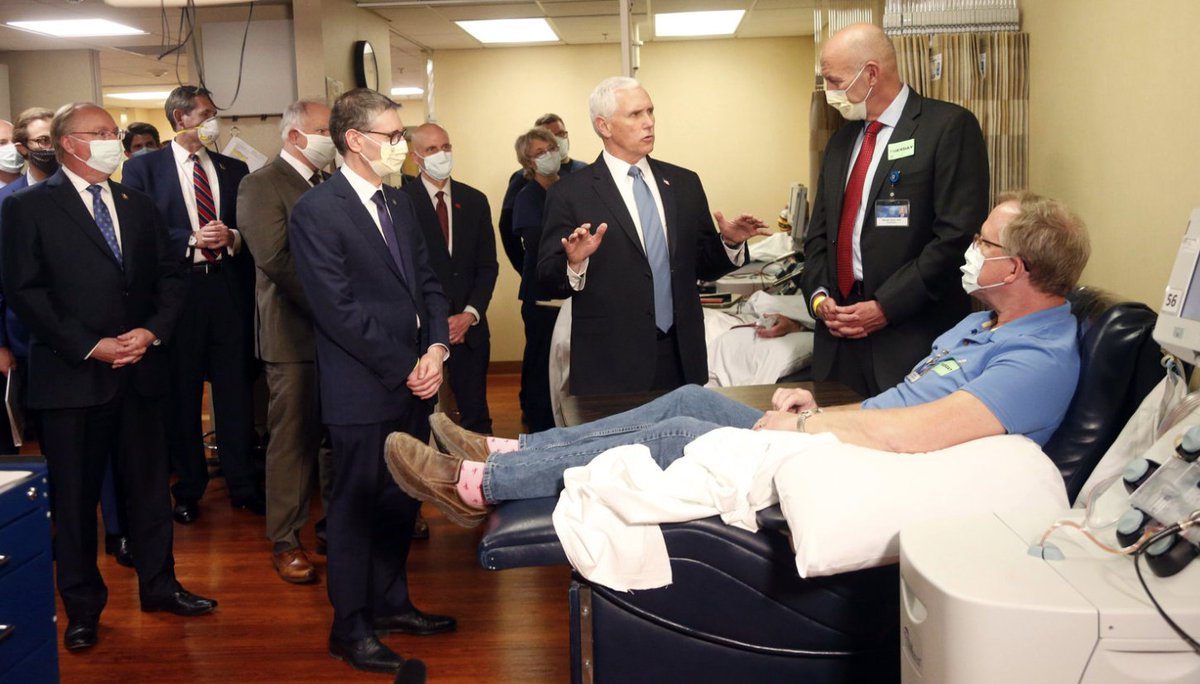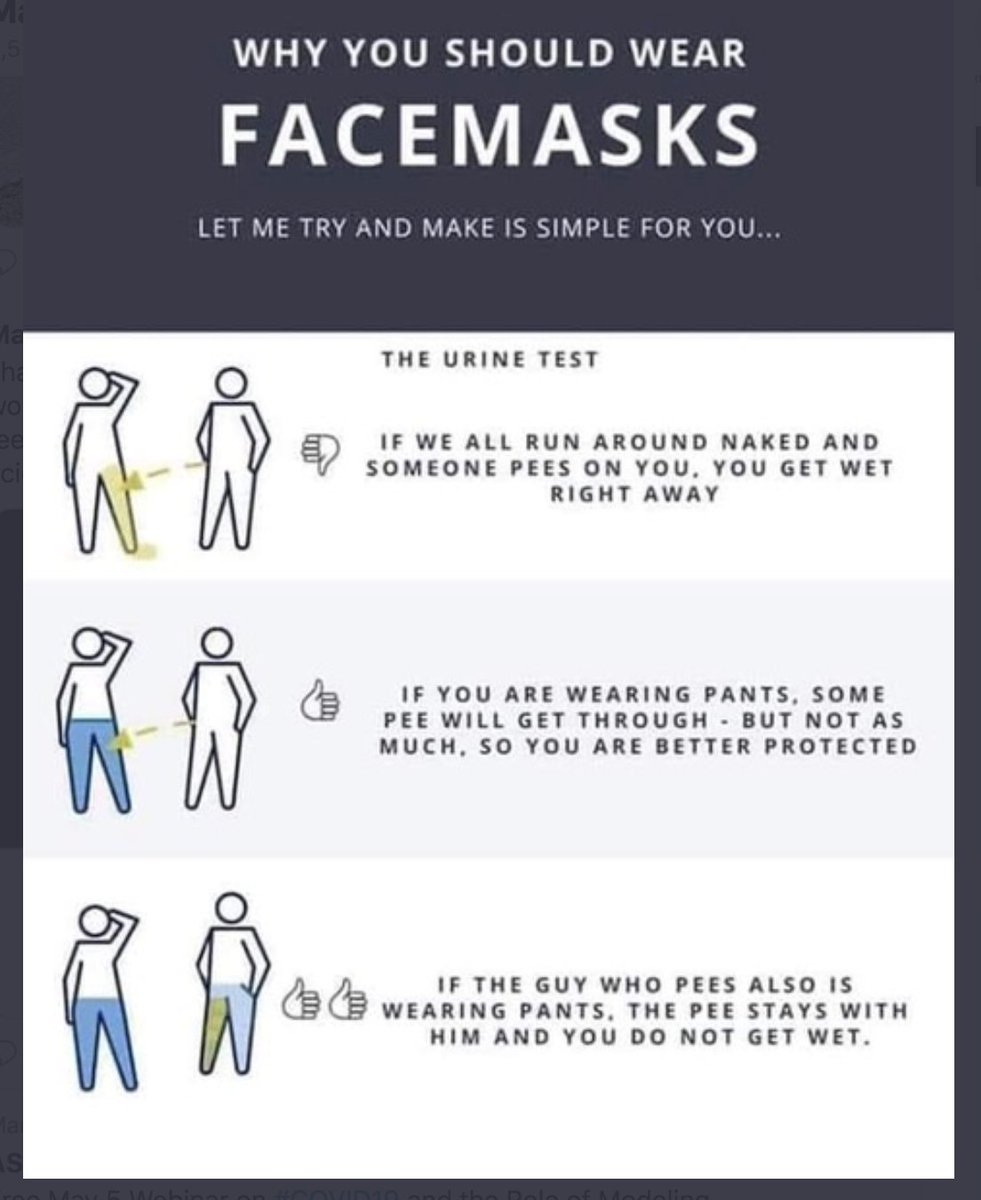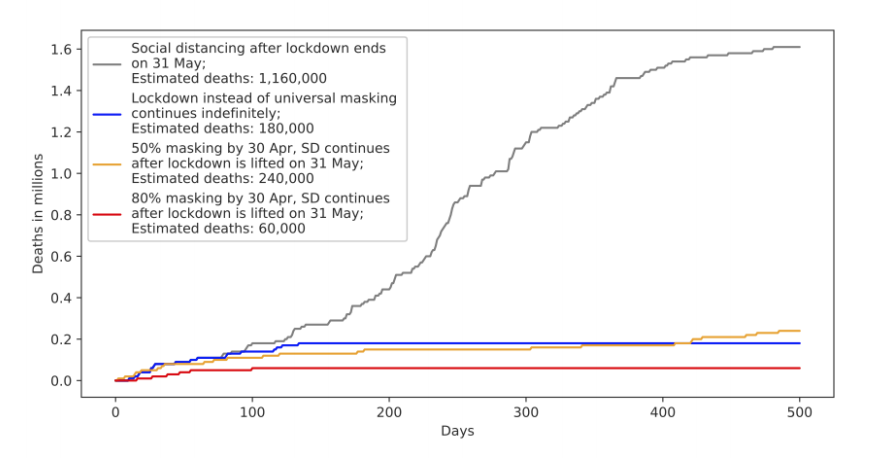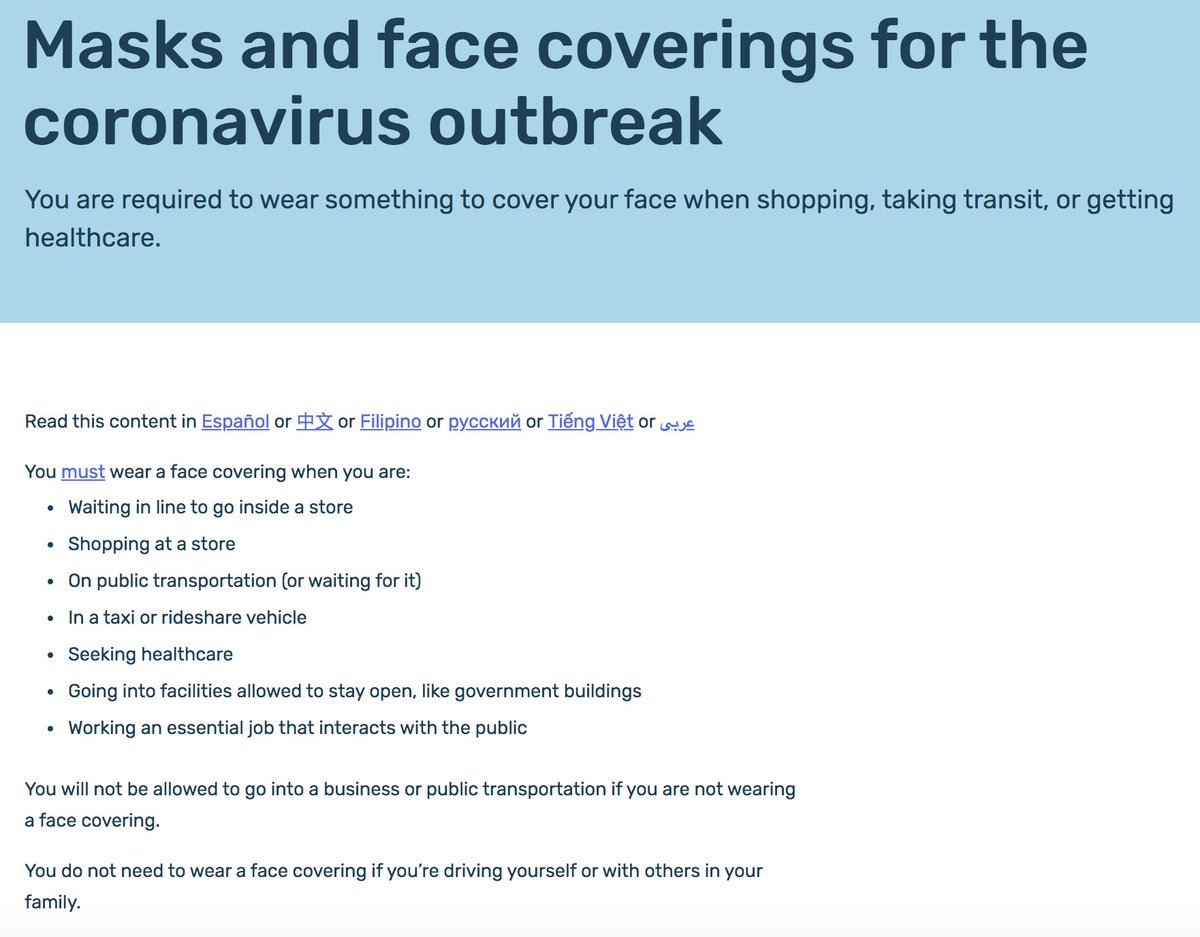1/ Covid ( @UCSF) Chronicles, Day 57
UCSF: 12 pts, 4 on vents. Clear downtrend (Fig L). Still only 3 deaths @ucsfhospitals. In March: >90% of my meetings were Covid-related. Now >90% concern hospital recovery.
SF data also good: falling case rate (Fig R), just 1 death in 12d
UCSF: 12 pts, 4 on vents. Clear downtrend (Fig L). Still only 3 deaths @ucsfhospitals. In March: >90% of my meetings were Covid-related. Now >90% concern hospital recovery.
SF data also good: falling case rate (Fig R), just 1 death in 12d
2/ It’s been wild seeing new Covid issues crop up, at least once a week: virus vs economy, hydroxychloroquine, death # s, antibody testing...
Today& #39;s issue: masks. Such simple things, yet so confusing. Do they work? Should they be required? How did they become new battleground?
Today& #39;s issue: masks. Such simple things, yet so confusing. Do they work? Should they be required? How did they become new battleground?
3/ Like many issues w/ Covid, mask-wearing exposes many fault lines in American life: facts vs emotion, protecting self vs others, state power vs individual liberty, the powerful vs everybody else. And the mask issue amps up the volume by adding yet another ingredient: vanity.
4/ Not surprising, then, that masks are now sizzling hot button issue https://bit.ly/3fOtLQn ">https://bit.ly/3fOtLQn&q... One vivid illustration: watching Senators at yesterday’s Fauci hearing make partisan statements by wearing, or not wearing, masks https://nyti.ms/3bsq6o9 ">https://nyti.ms/3bsq6o9&q... @poniewozik
5/ More: Pence @ MayoClinic https://wapo.st/2Z1d2DI ;">https://wapo.st/2Z1d2DI&q... And: Trump refusal to wear mask (new survey: 70% think he should, including most Republicans https://politi.co/2WUHj4e );">https://politi.co/2WUHj4e&q... Last: Tragically, store security guard killed after asking customer to mask her kid https://wapo.st/2WSfFEX ">https://wapo.st/2WSfFEX&q...
6/ The mask issue is really complicated (so this’ll be a bit long, sorry). All respected public health bodies now recommend masks, particularly when distancing is impossible. @CDCgov’s guidance here: https://bit.ly/3fLPB7d .">https://bit.ly/3fLPB7d&q...
7/ In discussing masks for everyday life, we’re talking cloth or surgical masks, not N95 masks, which are mostly used in caring for Covid pts in medical settings. N95s block most virus (95 stands for 95%) from reaching the wearer, by having thicker materials and a tight fit.
8/ Part of why mask story is tricky is cloth or surgical masks (surgical a bit better) mostly protect other people, though they do protect wearer somewhat. Thus, mandating them mixes the “What’s in it for me?” with the “Give Me Liberty or Give Me Death” veins of American culture.
9/ Best analogy I’ve seen for understanding how masks actually work to prevent Covid came from @mlipsitch. It’s called “The Urine Test,” and, while it& #39;s a bit crude, it& #39;s spot on. Shown below.
10/ Whatever the type of mask, building in sippy holes https://bit.ly/3cw0sjI ">https://bit.ly/3cw0sjI&q... or outlet valves (as in some masks in NorCal used during fire season) defeat the purpose. They should never be used if goal is preventing Covid spread https://bit.ly/2Ws8HaI ">https://bit.ly/2Ws8HaI&q... @sfchronicle
11/ Some argue that plastic face shields better than masks, since masks don’t cover eyes & do prevent seeing face https://bit.ly/2LoycmX ">https://bit.ly/2LoycmX&q... @jama_current Reasonable case, but to me a consistent message re: masks better than pivoting to promote shields (& no evidence shields better)
12/ Terrific review of science behind masks by @jeremyphoward https://bit.ly/3fLlj4r ">https://bit.ly/3fLlj4r&q... Recall my May 11 discussion re: viral dose https://bit.ly/2WTeMMv .">https://bit.ly/2WTeMMv&q... Since one viral particle won’t cause Covid, this means that masks don& #39;t need to block 100% of virus to prevent disease spread.
13/ Masks block droplets from spraying out of wearer& #39;s mouth. (They also remind us not to touch mouth/nose) We know that sneezing/coughing generate viral spray. But singing can do it too https://bit.ly/2LqqvNh ,">https://bit.ly/2LqqvNh&q... as can loud speaking https://bit.ly/3dJ4ipL ">https://bit.ly/3dJ4ipL&q... More reason to mask up.
14/ No controlled trials of masks; evidence is from observational studies. Having reviewed the literature, I agree w/ @jeremyphoward: “Preponderance of evidence indicates that mask wearing reduces the transmissibility per contact by reducing transmission of infected droplets...”
15/ Compelling case study https://bit.ly/2WsxBHb ">https://bit.ly/2WsxBHb&q... of person w/ Covid flying 15h on crowded plane. He wore mask; not clear if others did. Nobody got Covid. While only one case, it& #39;s hard to believe that, with 25 people sitting <6 ft away, no one would have caught Covid if no mask.
16/ Great @bmj_latest review by @trishgreenhalgh, whose conclusion (below) seems reasonable to me https://bit.ly/2LmB4B3 ">https://bit.ly/2LmB4B3&q... There are times where the evidence, though imperfect, is good enough to take action, & this is one of them. People, we’re talking about face masks, not chemo.
17/ One problem with the literature is that masking is rarely the lone intervention – it& #39;s usually part of a bundle of interventions incl. distancing, hand hygiene, etc. But it’s clear that countries w/ more masking (who tend to do other stuff too) enjoy lower infection rates.
18/ Key is getting folks to wear them. This figure shows that if masks are 50% effective (a conservative estimate) and 50% of people wear them (shouldn’t be too tough), transmission rate plummets (Ro from 2.4 →1.35). That saves a lot of lives, but still a lot of disease at 1.35.
19/ Simulation by @dekai123 makes case for 80% use https://bit.ly/3bx3G50 .">https://bit.ly/3bx3G50&q... The figure (below) shows that, for country the size of UK, social distancing only (without masking) would lead to 1.16 million deaths. With 50% masking: 240,000 deaths. With 80% masking: 60,000 deaths.
20/ If @dekai123’s mind-blowing video https://bit.ly/35Ywzpu ">https://bit.ly/35Ywzpu&q... doesn’t convince you of the virtue of mask wearing, I just don’t know what to tell you.
21/ Why is masking so hard? In Asia, masks now seen as normal accessory. In US, still seen as awkward and stigmatizing (historically, a sign of illness or danger). This, plus fact that benefit mostly to others, is why we need to make them mandatory… https://bit.ly/2WroeHO ">https://bit.ly/2WroeHO&q...
22/ …at least in closed spaces, as SF has done (Fig). Question of outside masks @WSJ https://on.wsj.com/35W08Z3 ">https://on.wsj.com/35W08Z3&q... With ~zero risk of spread outdoors if >6 ft, I don’t wear one when walking dog (but keep one with me). But I always wear mask inside or if a <6 ft encounter is likely.
23/ Some argue that the way to ensure high compliance with mask use is mandating them everywhere (including outside) – it’s what my epidemiology sensei @Rutherford_UCSF believes. “Need to make them normative,” he says, which might be the right policy call. I’d be fine with it.
24/ @ucsfhospitals CEO Mark Laret, after hearing mask talk by Rutherford, donned mask (despite being alone @ home). “George scared me straight, so I’m wearing a mask to protect myself from myself!” Might be overkill, but it’s the right idea.
Stay safe. Grand Rounds tomorrow…
Stay safe. Grand Rounds tomorrow…

 Read on Twitter
Read on Twitter